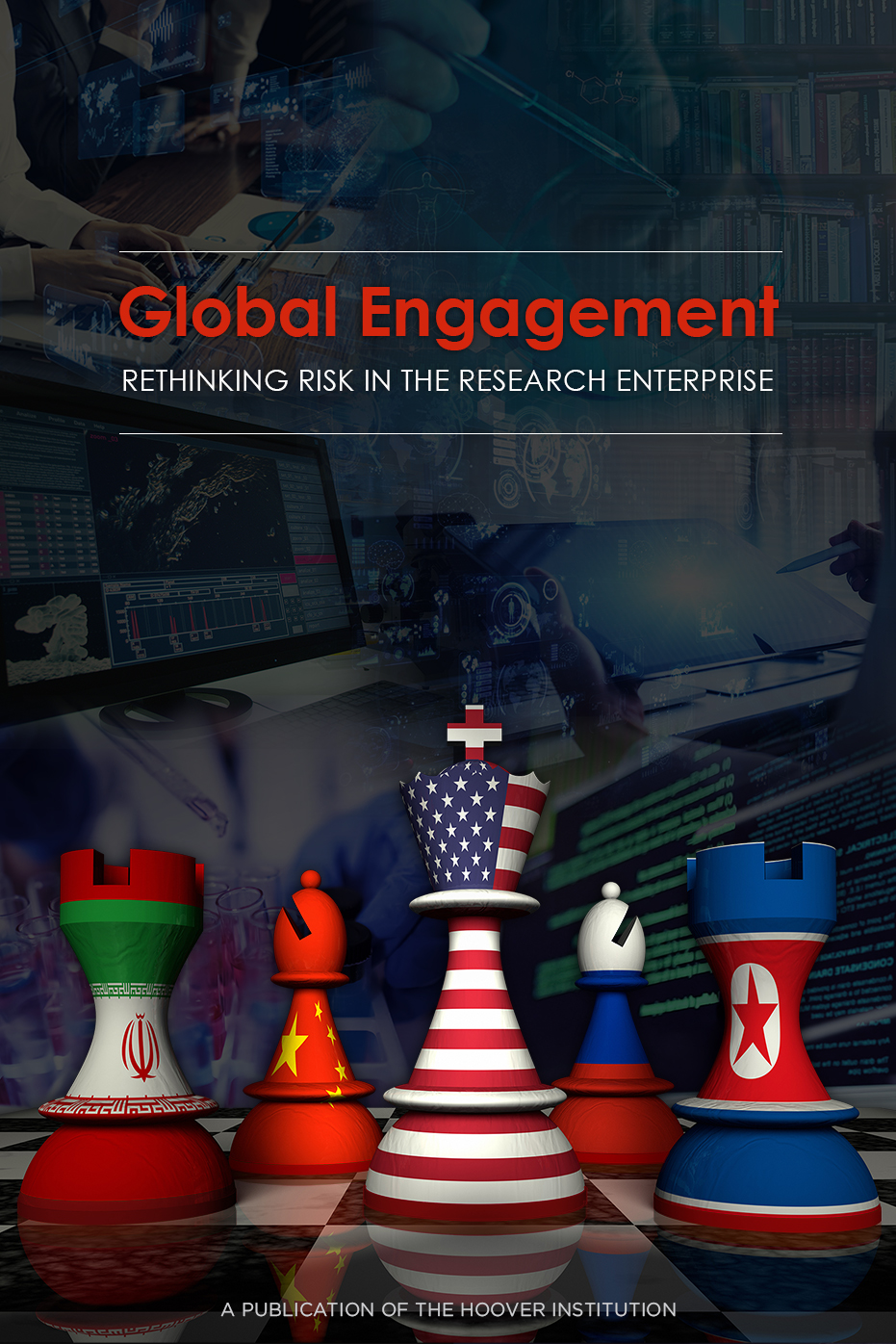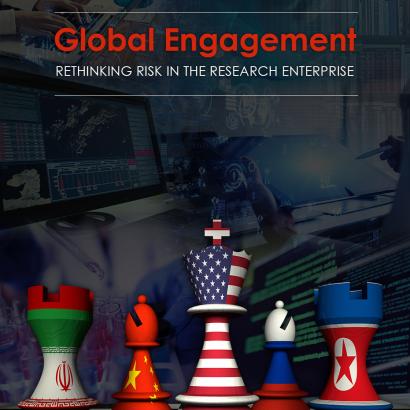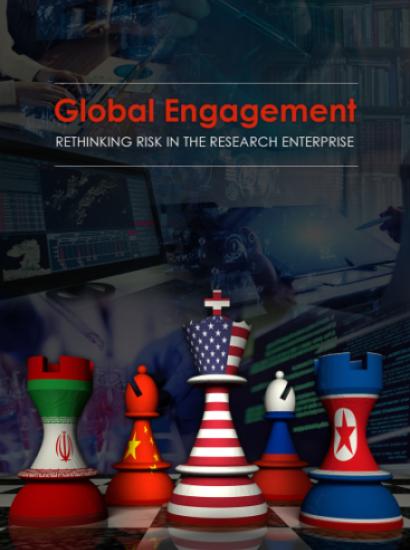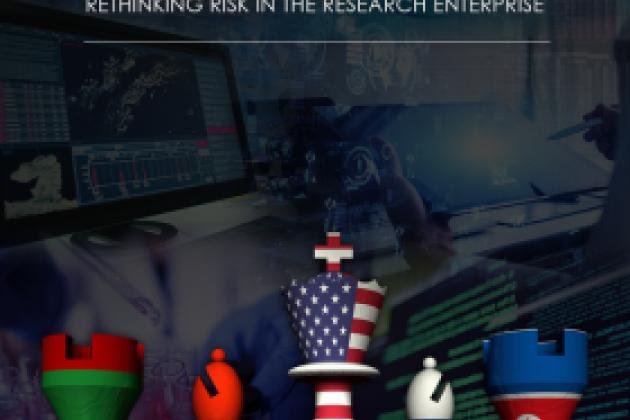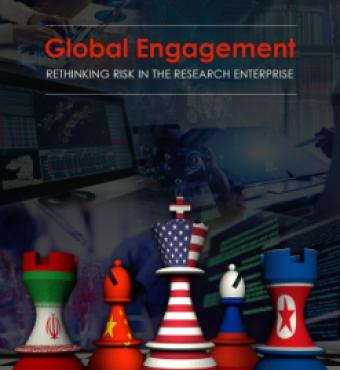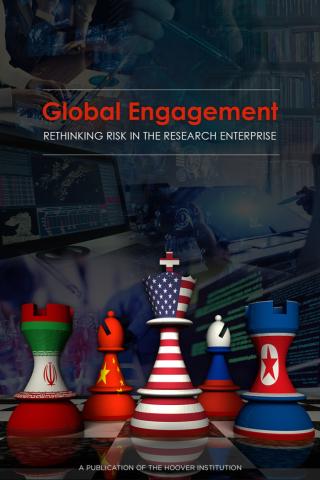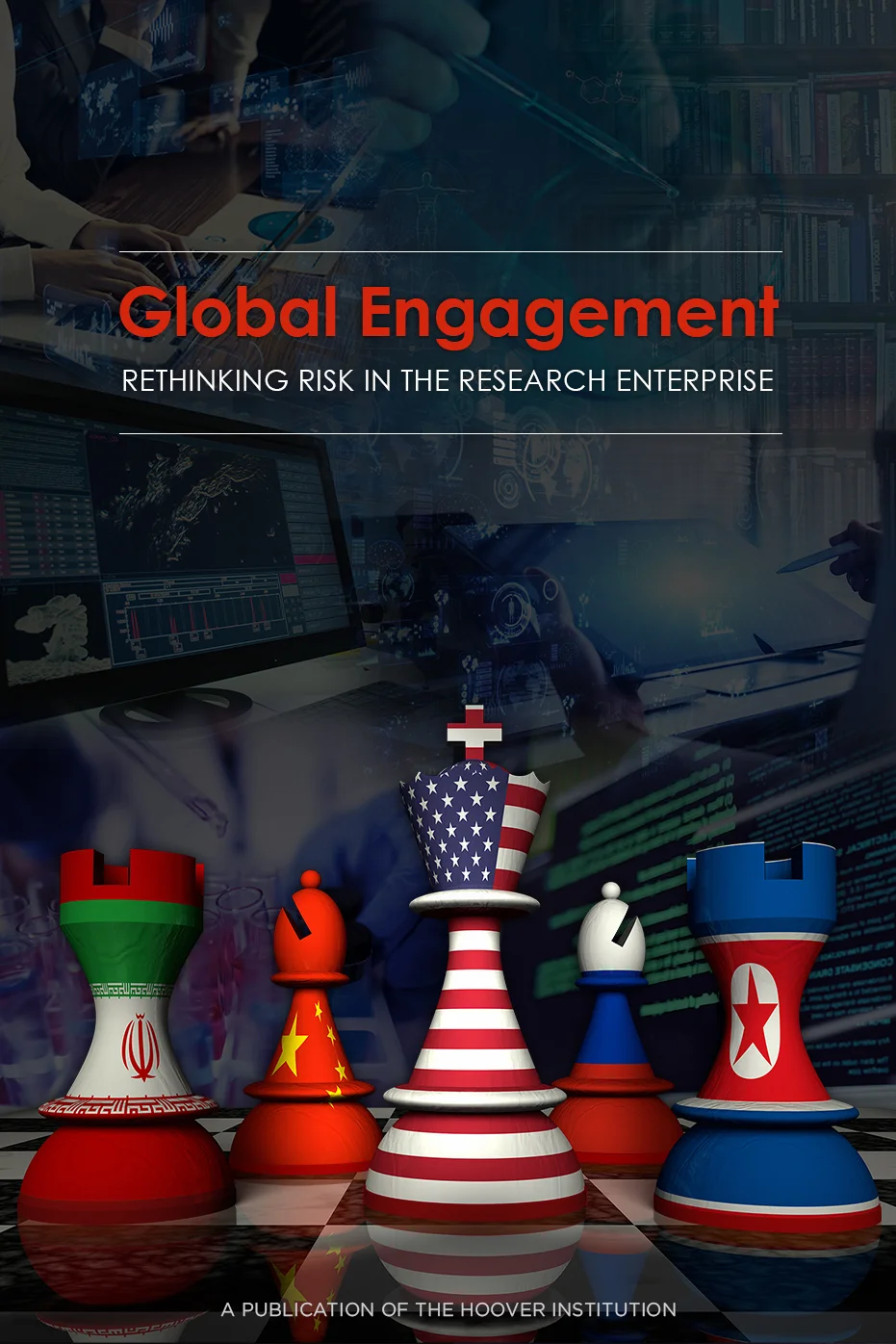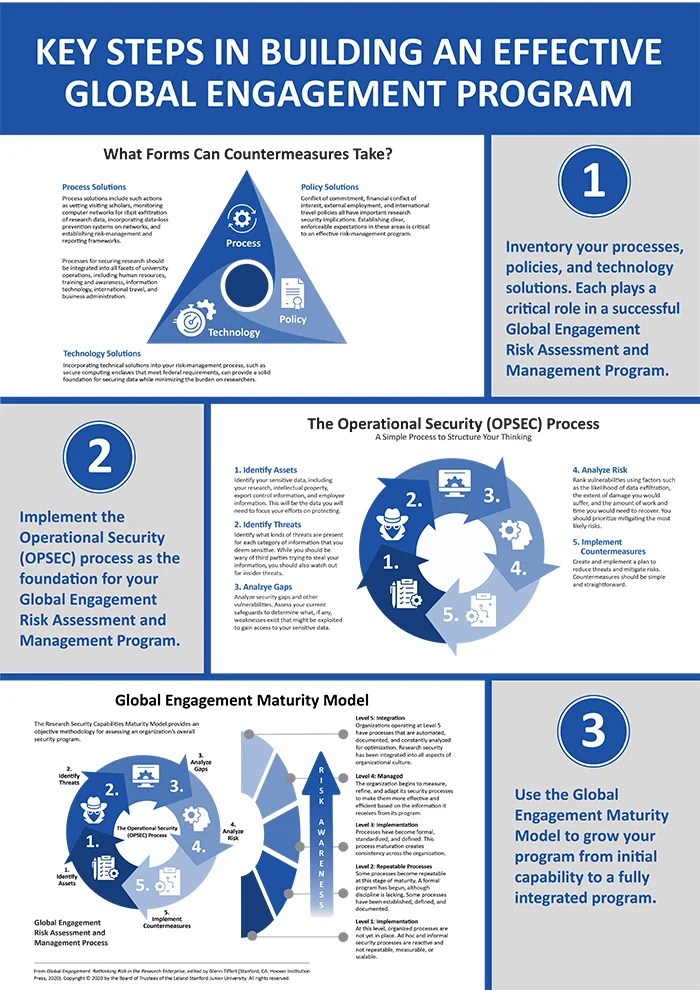Neither the US government nor the universities and national laboratories in the US research enterprise are adequately managing the risks posed by research engagements with foreign entities. The task is quite simply falling through the cracks. Data with which to assess the performance of current frameworks for managing foreign engagement risk, to identify their defects, and to devise proportionate fixes is consequently in short supply. Dueling narratives have filled this evidentiary vacuum, pitting some who propose incremental adjustments against others who call for far-reaching change. Without a common set of facts to anchor the debate, consensus has proven elusive.
This report offers a way forward. Chapter 1 identifies more than 250 published research collaborations between scholars based in the United States and counterparts from seven universities in the People’s Republic of China (PRC) that are integral to that nation’s defense research and industrial base. This report maintains that it is not in the US national interest to collaborate and assist with the military development efforts of the PRC, a nation that the US government increasingly views as a strategic competitor and military rival, even if the relevant research is unclassified, considered basic or fundamental, and is ultimately published in open sources.1 Such collaborations are emblematic of systemic flaws in the ways that the US research community approaches foreign engagement risk. To remedy those flaws, the research community should embrace a new, proactive risk assessment and management paradigm informed by the principles of Operational Security (OPSEC) and implemented through capability maturity modeling. Chapter 2 delivers that paradigm.
Background
Bound by constitutional principles, the US government has generally accorded US scholars and the institutions that employ them wide discretion to manage their own research affairs. The research community has in turn nurtured a climate that favors openness, autonomy, and collaboration. It follows a decentralized approach to governance that aspires to promote free inquiry in the pursuit of knowledge by insulating scholars not just from external political authority and economic power, but also from undue interference from their own administrators. The result is a deliberately permissive model that has performed extraordinarily well and that exemplifies and renews the values at the heart of a liberal democratic society.
At the same time, the permissiveness of this model leaves it open to exploitation by those who do not share its values, including illiberal regimes that have proven adept at taking advantage of its lightly policed spaces. For much of the last thirty years, American hegemony has permitted US research institutions the luxury of overlooking this vulnerability, freeing them to pursue globalization unencumbered by the complications of geo-strategic competition. But the shifting balance of power is now impinging on that latitude and forcing an uncomfortable reckoning.
The direct and largely unrestricted access that the PRC in particular has enjoyed to US research creates challenges for the United States and for the research institutions that rely on US government funding to support their work. Although these challenges do not always rise to the level of explicit illegality, in the realm of science and technology (S&T) research they can nonetheless adversely impact national and economic security and violate norms of academic integrity, ethics, or administrative rules. The challenges include (but are not limited to) the following:
• Conversion of US government-funded research into intellectual property that is then commercialized in the PRC in violation of research grant or university terms and conditions.
• Direction or redirection of US research to the PRC government by selectees of the PRC’s state-run talent recruitment programs.
• Improper PRC influence over, or manipulation of, US research grant evaluations and award decisions.
• Diversions of US research to PRC defense programs and weapons system development, which can undermine or eliminate US military superiority.
• Diversions of US research to applications that violate ethical standards or democratic norms and values, such as those that enable or enhance the PRC’s domestic surveillance apparatus and human rights abuses.
• Failing to report or misreporting foreign affiliations, research projects, and additional sources of funding in violation of federal research grant disclosure rules.2[2]
It would be a grave error to mistake the comparatively low number of publicized cases that dramatize these challenges as evidence that existing safeguards are sufficient or as grounds for complacency. Owing to gaps in oversight and reporting, cases have escaped detection, several of which this report brings to light. These cases establish that US scholars and research institutions have been contributing directly to the PRC’s military modernization.
Overview of the PRC’s Seven Sons of National Defense (Universities)
The seven universities profiled in Chapter 1 of this report have a long history of supporting the PRC’s military programs. The PRC’s Ministry of Industry and Information Technology (MIIT) has administered the universities since 2008 and refers to them as the “Seven Sons of National Defense” (国防七子).3[3] The group includes the following:
1. Beijing Institute of Technology (北京理工大学)
2. Beihang University (a.k.a. Beijing University of Aeronautics & Astronautics, 北京航空航天大学)
3. Harbin Institute of Technology (哈尔滨工业大学)
4. Harbin Engineering University (哈尔滨工程大学)
5. Northwestern Polytechnical University (西北工业大学)
6. Nanjing University of Aeronautics & Astronautics (南京航空航天大学)
7. Nanjing University of Science and Technology (南京理工大学)
All seven universities were originally founded either as institutes of the People’s Liberation Army (PLA) or from mergers of military engineering academies.4 They eventually became civilian universities (typically in the late 1970s and 1980s) and hence incorporate nonmilitary disciplines such as social sciences. Nevertheless, all seven stipulate that their core mission is to support the PRC’s defense research and industrial base and promote or execute military-civil fusion policies, which channel civilian research into military applications. Despite this shared mission, only four of the seven are on the US Department of Commerce’s Entity List for export control purposes.5[5]
Methodology
The findings in Chapter 1 of this report rest primarily on bibliographic data extracted from a corpus of 254 English- and Chinese-language articles published in the scientific and engineering literature between January 1, 2013 and March 31, 2019. The articles were identified by searching the China National Knowledge Infrastructure (CNKI) platform for publications with coauthors from one or more of the Seven Sons universities and at least one US institution. CNKI is one of the most comprehensive online aggregators of peer-reviewed academic journals, conference proceedings, theses, and dissertations in the PRC. Supplementary research, mostly in Chinese-language sources, was also conducted on the PRC-based coauthors and institutional affiliations appearing in the collected corpus.6[6]This report makes no claims regarding the comprehensiveness or representativeness of that corpus. The report’s scope is limited, and the cases it features were selected for the clarity of the risks that they expose. Because no technical assessments of the research implicated in these cases were sought, additional research would be necessary to characterize the concrete risks that they pose to US national and economic security. A deeper methodological discussion appears in the Appendix to facilitate such scholarship and to enhance due diligence efforts for risk assessment purposes.
Key Findings
With those understandings in mind, these are our key findings:
• The collected corpus of 254 articles names coauthors from 115 US research institutions. Most of these institutions are universities, but eleven are federal research facilities, including seven Department of Energy national laboratories and the US Naval Research Laboratory. US government funding sources were also credited in thirteen articles.
• PRC university departments employing coauthors who are named in the corpus have partnerships with the PLA’s General Armament Department, the PLA Rocket Force (which manages the PRC’s nuclear missile arsenal), and components of major state-owned defense conglomerates including: a) China Aerospace Science and Technology Corporation and divisions within its missile design and production subsidiary, the China Academy of Launch Vehicle Technology; b) China Aerospace Science and Industry Corporation; c) Aviation Industry Corporation of China and a subordinate research institute that supplies manufacturing technologies for defense industries; and d) China Shipbuilding Industry Corporation.7[7]• Several identified coauthors appear to have worked on classified defense projects, as indicated by “XXX” or “XXXXX” designators in their titles or funding codes; for example, a PLA General Armament Department “Panoramic View XXXXX System Preliminary Research Project.”
• Some coauthors’ biographies mention their work on projects for the PRC’s Central Military Commission Science & Technology Committee, PLA General Staff Headquarters, PLA General Armament Department, and PLA Unit 65927. One coauthor claimed to concurrently serve as a PLA General Armament Department Stealth Technology Experts Group member and a General Armament Department Military Use Electronic Components Technologies expert evaluator.
• One article named researchers from Northwestern Polytechnical University, a US university, and the Xi’an Engineering College of the People’s Armed Police (PAP), raising ethical concerns over applications of this research. The PAP performs domestic security and surveillance functions that help the Chinese Communist Party (CCP) maintain authoritarian control over the PRC’s population. The PAP’s Xi’an Engineering College subsequently merged with a PAP command unit in Xinjiang, which may implicate it in the mass detentions, internment, and repression of the region’s large Muslim population. No biographical information was found on the PAP-affiliated coauthor, raising questions about the degree of due diligence the partnering US institution might have been able to perform on this individual.
• Dissertations filed at some of the Seven Sons universities claim support from the US National Science Foundation (NSF) and the National Institutes of Health (NIH). The identified PhD candidates studied in the United States prior to completing their doctoral degrees and credit the PRC central government-run China Scholarship Council for providing funding support for their study abroad. By naming NSF and NIH funding sources in their dissertations, these students are indicating that they used US government-funded research conducted in the United States to fulfill at least part of their PhD degree requirements. The students may have been working under recipients of NSF and NIH funding (i.e., principal investigators) while receiving PRC government scholarship support to do so.
• Coauthors affiliated with US Department of Energy national laboratories have published research with six of the Seven Sons universities. Although some of this research is intended for civilian purposes (such as new energy development), some of the PRC-based coauthors have held positions at or worked on PLA programs.
• Some authors obfuscate their ties to defense programs by using incomplete or innocuous sounding English names to describe their affiliation with a subordinate division of a Seven Sons university. For example, the Chinese terms for “national defense key laboratory” were replaced with “state key laboratory” in English. English webpages of university departments associated with some coauthors also do not disclose numerous defense-related subdivisions listed on the universities’ Chinese-language websites. This obfuscation likely inhibits the ability of US research institutions to perform adequate due diligence on research partnerships.
• Some coauthors list no biographical information or curricula vitae (CVs) on their faculty pages or on the websites of their employing institution; in one case, a faculty profile on the Harbin Institute of Technology website is blocked from US internet points of presence. In another example, a CV was provided but does not mention any US affiliation despite naming one in an identified article.
• Several articles include coauthors from Huawei, a PRC telecommunications conglomerate that was added to the Entity List in 2019. The US government has identified national security concerns with Huawei, including suspected ties to PRC military and intelligence organs, alleged violations of economic sanctions, and intellectual property theft. Huawei’s role in the surveyed literature is unclear; nonetheless, it documents the conglomerate’s research relationships with key defense universities.
Conclusions and Recommendations
Citing a threat to long-term economic vitality and the safety and security of the American people, Presidential Proclamation 10043 of May 29, 2020, directs the US secretary of state to deny visas to study or conduct research in the United States to any postgraduate student or researcher from the PRC “who either receives funding from or who currently is employed by, studies at, or conducts research at or on behalf of, or has been employed by, studied at, or conducted research at or on behalf of, an entity in the PRC that implements or supports the PRC’s ‘military-civil fusion strategy.’ ”8[8]This report concludes that the proclamation’s threat narrative is empirically well-founded. The PRC’s “Seven Sons of National Defense” universities directly support military-civil fusion; the PLA; and the defense research and industrial base, weapons programs, and myriad other entities that are part of the PRC’s military, public security, and surveillance apparatus. Scientific collaboration between US research institutions and these seven PRC universities has promoted the missions of those entities, compromised US national and economic security, and undermined the integrity of US research.
Proclamation 10043 is a forceful intervention in a long-neglected problem. Yet, if the past is any guide, then the PRC will adopt circumvention strategies in order to frustrate the proclamation’s aims. This report documents cases of PRC entities, students, and researchers obfuscating or misrepresenting their identities. In addition, collaborations with US partners may shift online or outside of the United States. Research institutions must prepare for such contingencies on their own initiative and develop equally adaptive and robust internal processes in response or the US government may step in and impose blunt alternatives.
The binary test of (il)legality by which S&T collaborations with PRC entities are conventionally assessed sets too high of a bar and is plainly insufficient to satisfy that requirement. Most, if not all, of the collaborations featured in this report may have been legal at the time that they were undertaken. This report furthermore assumes that their research content qualified as basic or fundamental and was therefore not subject to export or classification controls by the US government. In addition, failures to disclose foreign collaboration by federal research grant recipients may have reflected faulty compliance rather than intentionally unlawful activity. New approaches to identifying and managing risk are urgently required.
The authors of Chapter 1 therefore make the following four recommendations:
1. Expand the scope of this report.
• Other articles within the collected corpus merit scrutiny to identify potential risks to US entities. Further studies using the methodology detailed in the Appendix may identify US research collaborations with other PRC institutions that support the PRC’s defense programs, especially those beyond the immediate compass of Presidential Proclamation 10043. This methodology could also be applied to collaborations with institutions and researchers from other nations.
• The economic implications of US-China research collaboration should be explored more fully. As PRC universities have partnerships with state-owned enterprises in both civilian and military sectors, further investigation is needed to determine if US taxpayers are funding technologies that are patented or commercialized by PRC universities or partner companies.
2. Expand vetting and due diligence of collaborations with PRC partners.
• US research institutions should determine if the US-based coauthors were recipients of or worked on federal grants that related to the research published in the scientific literature this report identifies.
• US research institutions should compile information on all PRC organizations that have demonstrable connections to the PRC’s defense research and industrial base. They should obtain this information primarily through PRC-based vernacular information sources and create collective information sharing mechanisms that can be used to enhance vetting of visiting PRC students and scholars, as well as ramp up due diligence on proposed or existing research partnerships with the PRC.
• US research institutions should partner / share information with foreign allies to enhance those nations’ due diligence and risk assessments since the PRC’s Seven Sons universities collaborate with many nations, not just the United States.
3. Enhance administrative oversight.
• Benign research cannot be separated a priori from potential dual-use applications pursued by foreign institutions that support defense research such as the Seven Sons universities. US research institutions should mandate disclosures and preapprovals for all forms of S&T collaboration with PRC institutions—even when the research is considered fundamental in nature or published openly—and undertake disciplinary measures when individuals fail to seek approvals. Effective oversight depends on comprehensive reporting and periodic review.
4. Create or revise common moral and ethical standards with respect to research collaboration in academia.
• US research institutions should create a common framework to determine when research collaborations, student and researcher exchanges, and other forms of partnership may contribute to the military or domestic repressive capabilities of authoritarian regimes, violate democratic values or human rights, or involve unethical research practices.
• US research institutions should develop, maintain, and share lists of foreign partners (distinct from governmental lists) that they consider off limits for collaboration based on agreed-upon standards and documented evidence of programs, activities, or associations that are inimical to US interests and values.
The authors of Chapter 2 of this report build on these foundations. Taking up the question of how to reconcile an open and globalized research enterprise with the imperative to safeguard US national security and economic competitiveness, they propose a new paradigm for governing foreign engagement risk, regardless of its country of origin. Six additional recommendations flow from that.
5. Enhance due diligence and compliance for all foreign engagements.
• To ensure that US research institutions exercise their discretion to undertake foreign engagements wisely, they must redouble their efforts at basic due diligence and compliance. At a minimum, this includes better vetting of prospective partners and funders; careful scrutiny of the terms of proposed collaborations, especially when they involve formal contracts and agreements; constant iteration and adaptation of risk governance processes; and formal integration of diverse stakeholders, including area and subject matter specialists, into those processes.
6. Establish a strategic global engagement risk assessment and management program.
• Reclaiming control over foreign engagement risk begins by bringing all of an institution’s international engagements under the governance of a unified strategic program. This program would impose coherence on policies and processes that rigorously assess the nature and degree of risk that foreign engagements pose and guide proportionate measures to mitigate those risks to acceptable levels.
• The program must incorporate the following: practical training in compliance mandates, and in risk awareness and mitigation for both formal and informal foreign engagements; transparent reporting and record keeping processes; and regular performance reviews.
• The program could support jointly administered regional vetting centers and secure computing enclaves, which would allow member institutions to spread costs, pool resources, and provide internal clients with security as a service at economies of scale. These regional facilities would establish cooperative points of contact with government partners to facilitate information sharing and compliance.
7. Establish a strategic global engagement review office.
• Each research institution should establish a stable, accountable authority with the institutional capital to drive its strategic global engagement risk assessment and management program to success across multiple constituencies.
• This Global Engagement Review Office would supervise program implementation and exercise unified leadership over foreign engagement risk policies and processes across the institution. In a typical university setting, it would report and make recommendations directly to the provost and advise other principals on foreign engagement risk. It would complement and coordinate with other units, such as export control and facilities security, that are commonly under the authority of the vice provost for research.
8. Change the paradigm.
• Research institutions should adopt Operational Security (OPSEC) as their governing paradigm for assessing and managing foreign engagement risk in order to cement a more proactive and adaptive posture than traditional compliance-driven approaches can deliver. OPSEC supplies a workflow for sustaining vigilance and innovation.
9. Embrace maturity modeling to consolidate and develop capabilities.
• Adoption of a global engagement maturity model establishes a methodology for formalizing and optimizing a global engagement risk assessment and management program from inception to full integration with an institution’s operations. Such a model defines a ladder that institutions can climb to achieve and communicate preparedness for more demanding work requirements. Combined with OPSEC, this model promotes perfection and growth in an institution’s capabilities.
10. Establish a government-sponsored entity to support better decision making.
• Research institutions have unequal resources and capabilities and cannot abate foreign engagement risk alone. Government support is essential but currently fragmented and scoped too narrowly. A new interagency entity combining the equities of multiple government stakeholders and their open-source data streams could provide an urgently needed, unified point of contact for the research enterprise on compliance matters and foreign engagement risk; deepen relationships of trust; facilitate routine information sharing; and enhance research and analysis so that institutions can make better and more granular decisions for themselves.
Notes
1.National Security Council, United States Strategic Approach to the People’s Republic of China, May 26, 2020, https://www.whitehouse.gov/articles/united-states-strategic-approach-to-the-peoples-republic-of-china.
2.White House Office of Science and Technology Policy, Enhancing the Security and Integrity of America’s Research Enterprise, June 2020, https://www.whitehouse.gov/wp-content/uploads/2017/12/Enhancing-the-Security-and-Integrity-of-Americas-Research-Enterprise-June-2020.pdf.
3.吴志华 [Wu Zhihua], “国防七子”招生就业办领导首秀江西国科 [“National Defense 3 Sevens Sons” Admissions and Job Placement Office Leaders Visit Jiangxi National Defense Technology Military Industry Group for the First Time],” 国家军民融合公共服务平台 [National Military-Civil Fusion Public Service Platform], June 21, 2017, http://jmjh.miit.gov.cn/web/newsInfoWebMessage.action?newsId=493942&moduleId=1062.
4.The exception is Harbin Institute of Technology, which was founded in 1920 (seven years before the PLA) but has focused on supporting defense research for most of its history.
5.Beihang University, Northwestern Polytechnical University, Harbin Engineering University, and Harbin Institute of Technology are on the Department of Commerce’s Entity List. The latter two were added on June 5, 2020, after the data for this report was collected.
6.For the purposes of this study, bibliographic data includes article title, authors, affiliated institutions, publication source, date, funding details (if provided), etc.
7.The PLA’s General Armament Department is now known as the Equipment Development Department of the Central Military Commission.
8.US President, “Proclamation 10043 of May 29, 2020: Suspension of Entry as Nonimmigrants of Certain Students and Researchers From the People’s Republic of China,” document 85 FR 34353, Federal Register 85, no. 108 (June 4, 2020), https://www.federalregister.gov/documents/2020/06/04/2020-12217/suspension-of-entry-as-nonimmigrants-of-certain-students-and-researchers-from-the-peoples-republic.







